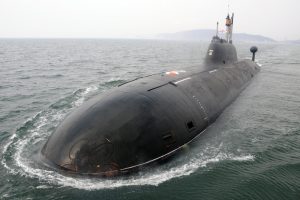The Indian government has just approved a proposal to purchase six conventional submarines under Project 75 (I). The Indian Defense Minister Rajnath Singh tweeted that the Defense Acquisition Council (DAC) “approved issue of RFP [Request for Proposal] for construction of six Conventional Submarines under Project P 75 (I) under the Strategic Partnership (SP) Model.”
The construction of the submarines is estimated to cost around $5.9 billion. Singh called it “a landmark approval,” as it is the first case processed under the strategic partnership framework for Make in India projects. He added that this will result in a “tiered industrial ecosystem for submarine construction in India.” There can be no doubt about the inordinate delays in this project, considering that this step represents just the RFP approval for an acquisition that was originally sought in the 1990s.
The Strategic Partnership Model (SPM) is a method established under India’s 2020 Defense Acquisition Procedure (DAP) with the goal of encouraging the Indian private defense sector to manufacture four key types of defense equipment: submarines, fighter aircraft, helicopters, and armored fighting vehicles /Main Battle Tanks. The SPM is the latest effort by the Indian government to strengthen and transform the India’s domestic defense manufacturing capability, yet another step toward a decades-long pursuit of self-reliance in defense. Under the SPM, the contract will reportedly be given to “a consortium” made up of an Indian submarine builder and a foreign Original Equipment Manufacturer (OEM).
India has around 15 conventional submarines in operation, many of which require immediate replacement as they are already obsolete. The Indian Navy also has two nuclear-powered submarines, the INS Chakra (leased from Russia, which is apparently being returned) and the indigenously built INS Arihant. India’s submarine acquisition plans through the earlier Project 75, which was supposed to have been completed by around 2017, have also seen considerable delays. The last three of the six Project 75 Kalvari (Scorpene)-class submarine are expected to enter service only in the next two years.
The plans under Project 75(I) were for India to build another six advanced conventional submarines in collaboration with a foreign manufacturer. Toward the end of 2019, South Korea’s Daewoo Shipbuilding & Marine Engineering joined the race for the contract against four other contenders: Naval Group (France), Navantia (Spain), Rosoboronexport (Russia), and TKMS (Germany). The Swedish defense firm SAAB was originally a contender for the contract, too, but decided to pull out because of the tedious and impractical conditions attached to the bid, especially as they would have to potentially give up control of the joint venture to their Indian counterpart.
At the beginning of this year, the government shortlisted Larsen & Toubro (L&T) and Mazagon Dock Limited (MDL) as partners for submarine manufacturing under the SPM, but the private sector is not pleased with the decision to include MDL because it is a public sector firm which is already engaged in shipbuilding. As next steps, L&T and MDL are to identify their foreign partners as well as come up with technical and commercial proposals. Under the latest acquisition policy, both L&T and MDL can submit multiple submissions by partnering with more than one foreign OEM. This has all the makings of a chaotic and unsatisfactory process, with clear conflicts of interest rising between the two Indian firms and their (potentially) multiple partners.
L&T is reportedly upbeat about the government decision and the SPM approach that provides a level playing field to the domestic private industry. Naval technologies are complex and involve significant R&D investment, and given the paucity of naval manufacturing capacity in the domestic context, the few that have made consistent investments in R&D like L&T stand to gain from the opening up of the sector.
There are other troubles facing India’s submarine indigenization efforts. The last two submarines developed under the earlier Project 75 Kalvari-class (or Scorpene-class) were supposed to be fitted with AIP system. AIP systems allow diesel submarines to stay submerged for much longer. This removes a key vulnerability in diesel submarines: their need to periodically surface. But the slow development of the system by the Indian Defense Research and Development Organization (DRDO) has meant a significant delay for the Indian Navy’s submarine plans.
After considerable delays, the Naval Materials Research Laboratory (NMRL) of the DRDO demonstrated the indigenously developed AIP system in March this year. But the demonstration took place on a “land-based prototype” and the DRDO has to now develop a “marinized” AIP system, that can be deployed on submarines to function under underwater situations. It is an important technology development but according to reports citing naval sources, the NMRL’s AIP system can be fielded only by 2023-24. This means that the six submarines that will be developed under Project 75 (I) cannot be fitted with the domestically produced AIP system. The naval sources reportedly said that the six new submarines will possibly be fitted with foreign AIP systems, and the DRDO-developed system, “will from 2024-25 onward, be ‘retrofitted’ into six Scorpene submarines,” developed under the older Project 75.
The Indian naval plans face other delays also. The military writer Rahul Bedi points out that there are other significant shortfalls of the Indian Navy including essentials capacities such as “advanced towed array sonars (ATAS) to detect enemy submarines, heavyweight torpedoes to neutralize them, and varied air defense systems, all of which are critical not only to their survivability, but also their overall offensive capability.”
Given these delays, there is little likelihood that the Indian Navy’s submarines woes will end any time soon. This is not something that India’s partners will want to hear either, considering that China’s naval power is growing at an astounding rate.
































